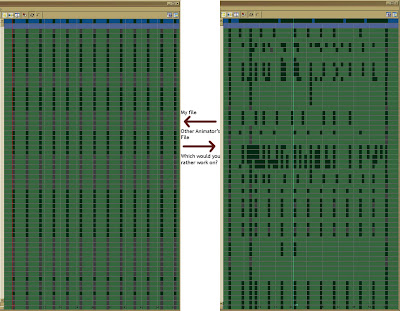- 上層分類: 動畫製作
- 分類: 動畫與 Rigging
- 作者 Chris
【5個格數 - 動畫方法 】【翻譯:Chris Deli】
Five frames by Michael Carr
“5個格數” 翻譯:Chris Deli
Along with first pass/final pass one of the earliest rules I learned as an animator was
very simple and very important:
Keep your poses 5 frames apart. Our art director at the time was more like a lead
animator and he stressed this idea upon me any time I handed off an animation.
I have worked this way for ten years and rarely adjust timing because of it.
延續著之前的first pass/final pass 的文章, 在我早期當動畫家時,領悟到的那麼多
規則裡面,其中一個最簡單也是最重要的就是
“每5個格數設一個pose(角色姿態)” 這個理論是早期每當我交出動畫給美術指導
看的時候, 他都會對我提起這個概念.
十年的工作經驗上我都是使用這樣的方式, 而且這中間很少會需要特別去調整
timing(動作時機)
Whether at 30 frames per second or 60 this workflow will ensure that your files are
clean and well organized and, over time, surprisingly precise.
The basic idea is to think, "Where does this character need to be in 5 frames?"
不管你的流程是30格數為一個秒,還是60格數, 這都會保證你的檔案看起來是乾
淨而且規劃整齊,更會意想不到的精確.
最基本思考的概念就是 “在5個格數後, 這個角色將會在哪裡”
Once you start to think in 5 frame snippets you will begin to see a marked
improvement in your posing as well as your timing.
The amount of frames between keys will show you exactly enough information for
adjustments.
If you stop playback somewhere between your keys and the pose doesn't look good
you either need an in-between, more frames, or need to rethink the bookend poses.
當你開始思考用5個格數為一個片段的時候,你會發現你的動作姿態與時機會有
明顯的進步.
在各關鍵格數中間的格數會提供足夠的資訊給你做調整.
如果你在撥放動作影片途中發現不對勁而停住影片, 這時候多辦是因為你需要
in –between (中間畫), 或是更多的格數,
也有可能是你需要重新思考這個穿插中的動作姿態.
The 5 frame rule also helps me animate from start to finish without having to revisit
sections or go back in to the middle of a file.
I'm constantly thinking about where the next pose needs to be and simply shaping it
out of the pose that came before.
In this way I'm very minimalist with my keys(though most animators should not be).
If something moves, it gets keyed.
If it doesn't change, I might not key it at all (Very true of feet) and can instead stay
focused on the moving parts.
If I need to go back and move something static later I know that it's safe to key it on
a multiple of 5 because everything else is.
When an animation is finished only then do I bother making nice clean rows of keys
for every control but, for the most part,
all the controls already are in nice, clean rows every 5th frame.
這”5格數規則” 使我可以一口氣調整動作從開始到結束, 這中間不需要回去重新
檢查之前所調好的部份又或者是回到檔案的中間去尋找錯誤.
因為我持續的思考這個角色下一個姿態是如何, 然後單純的依照上一個姿態調整
他。
依照這樣的步驟, 我將會擁有最低限的關鍵格數(通常大部份的動畫師不應該會
有).
當有東西移動了, 他將會被設上(keys)關鍵.
如果那東西沒有移動, 我可能不會設上任何(key)關鍵 (好比如”腳”), 這樣就可以
專注在於那些移動的部份.
如果當我必須要移動那些還未設上任何關鍵的部位, 我很直接的就知道我必須設
在5的倍數關鍵格上面因為其他部份的都是.
當動畫調整完畢時, 最需要在乎的地方就是把控制器的關鍵格數整理乾淨, 但是
絕大部份都已經乾淨的落在每間隔5格數上面.
Animating from start to finish also means that my poses flow kinematically into one
another.
There is only so much change that can happen in 5 frames and pulling the next pose
from the one before it leads to better, smoother arcs.
Some people may argue that animating this way eliminates secondary motion but
that's entirely untrue.
Smart posing includes secondary motion. You are constantly working in moving arcs
that pass through points (key poses) at varying speeds that you can control.
When you define the speed of the "in" and the "out" you don't need to add extra
keys.
Adjusting your curves later on can only improve how much or how little secondary
motion occurs.
從頭到尾的調整動作也代表著我的動作姿態是流暢有接續感的串連著,
因為在5個格數裡面並不會有太多太大的變化, 當你接續著上一個動作姿態調整
下一個, 這將會使動作更加完美, 更流暢的動作弧線.
有些人可能會爭辦說, 這樣的方式會使得我們不在注意其他secondary motion(連
帶動作), 但那是不完全正確的.
一個好的動作姿態包含著secondary motion連帶動作, 你是依據有規律性的動作
弧線並在可控制中的範圍內以不同速度經過這些關鍵動作.
這樣子當你定義你的淡入以及淡出時就不用增加任何新的keys(關鍵).
事後調整動作曲線只會改進很微小的secondary motion的存在或發生.
Of course there are moments that need to snap on a frame or animations that
require different timing or in-betweens
but, generally speaking, posing across 5 frames is a great organizational time
saver.
Every project I have worked on always has that one animator who keys on
ticks or percentages of a frame. I hate that guy.
5 frame animating eliminates that guy. It ensures your files will be clean and
easy to adjust.
It will also make you faster not having to worry about where your keys are.
Another benefit of this method is that it becomes clear to others how your file
is organized.
Other animators won't have to figure out why there is a sea of keys on every
frame because you moved a toe or adjusted a foot in an off key.
As a final bonus designers will be able to see your poses better and break
down where to add their magic, too.
Cleaner animation leads to better work all the way down the pipe.
當然有的時候是在動作裡面是需要不一樣的timing (動作時機)以及in-
between(中間畫).
但一般來說, 將你的動作姿態以5格為單位是一個有組織性的減少工作時間.
我製作過的案件上,總是會有動畫師把關鍵格數設在百分之幾的格數(翻:我想這
裡應該是指把keyframe設在1.34這樣奇怪格數上). 我討厭那樣的傢伙.
“5格數規則”將會讓這樣的人消失. 它會讓你的檔案乾淨並容易調整.
它也使你製作速度加快因為不用去擔心你的關鍵設在哪裡. 另一個好處就是,你
讓你的夥伴更清楚知道你如何整理這些關鍵.
其他的動畫師將可以很明確的看清楚你的動作姿態然後分解並加上他們的魔法.
乾淨的動畫將帶來更好更順暢的工作流程.
Strangely enough this concept somewhat mirrors Japanese animation, which
is often animated on 4s.
To save time and money less frames are used for animation which forces
animators to work in smarter, cleaner poses.
Less space to communicate ideas results in a need for clearer language of
motion.
Denying yourself the ability to do in-betweens will force you to be clearer in
your language, too.
很奇妙的是, 這個概念反映出通常以4格格數為單位的日本動畫.
因為他們必須提供聰明的,乾淨的動作姿態來減少他們的製作成本與時間.
當沒有足夠空間去討論想法時,這樣乾淨的動作溝通是被需要的.
否決自已調整中間畫的能力也將會強迫你自己擁有更清楚的溝通.
If you still doubt this workflow, take a messy file with a lot of keys and grab all
the controls.
Key them all every 5 frames and delete anything in between. You'll be
surprised how little the animation changes.
如果你還是對這樣的工作流程有疑慮, 找出一個擁有複雜又亂的關鍵格的檔案
然後選取全部的控制器,分別把他們的關鍵格距離調整5個格數,然後把所有的中
間畫 刪掉.
你將會驚訝發現只有微少的動畫改變.
原文來源: http://whiskeypail-test.blogspot.com/2011/05/five-frames.html
------------------------------
【W⁺】原文的留言也很精采:
Gareth 也分享這這段影片, Kevin Freeman 分享觀於工作流程的思考
------------------------------
【W⁺】如果你對共編社群有所想像,覺得可以如合作會更好的話,非常希望你能與我們分享,感謝喔!
專頁:https://www.facebook.com/animapp

